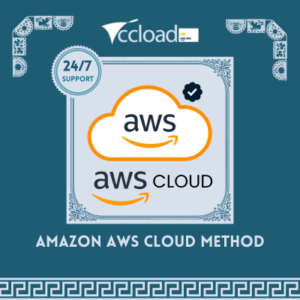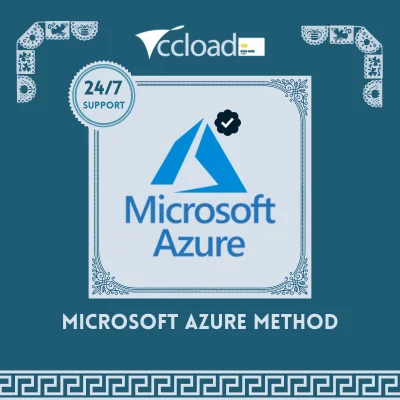Buy Microsoft Azure Method
- Lifetime Free Support
- 100% legal
- Following Policy
- Full Refunds
- 24/7 Free Support
- Instant Delivery
Instant Automated Delivery Systems.
😊 41 people 43 people 46 people 52 people 29 people 22 people 41 people 16 people 60 people are viewing this right now
Coupon Code : VCCLOAD
We accept
To buy Microsoft Azure, visit the Azure website and select a suitable subscription plan. Follow the on-screen instructions to complete your purchase.
Microsoft Azure is a leading cloud computing platform offering a range of services such as computing, analytics, storage, and networking. Businesses can leverage Azure to build, deploy, and manage applications through Microsoft’s global data centers. Azure supports various programming languages, tools, and frameworks, making it versatile for different development needs.
It provides robust security features, ensuring data protection and compliance. Azure’s scalability allows businesses to adjust resources based on demand, optimizing costs. With its comprehensive suite of services, Azure helps companies innovate and grow. Whether for small businesses or large enterprises, Microsoft Azure offers tailored solutions to meet diverse needs.

What Is Microsoft Azure?
Are you considering investing in cloud computing? Buy Microsoft Azure Method is a solution to explore. But first, let’s understand what Microsoft Azure is and how it can benefit your business. Microsoft Azure is a comprehensive cloud services platform designed to help organizations build, deploy, and manage applications through Microsoft’s global network of data centers. It offers a wide range of services, including computing, analytics, storage, and networking, making it a versatile choice for businesses of all sizes.
Microsoft Azure Features
Microsoft Azure provides an array of features that cater to various business needs. Here are some of the key features:
- Scalability: Azure allows you to scale your resources up or down based on your business needs, ensuring you only pay for what you use.
- Security: Azure offers advanced security features, including encryption, identity management, and threat detection, to protect your data and applications.
- Hybrid Capabilities: Azure supports hybrid cloud environments, allowing you to integrate on-premises and cloud resources seamlessly.
- Global Reach: With data centers in multiple locations worldwide, Azure ensures low latency and high availability for your applications.
- Cost-Effective: Azure’s pay-as-you-go pricing model helps you manage your budget effectively, reducing unnecessary expenses.
Below is a table summarizing some of the primary features of Microsoft Azure:
| Feature | Description |
|---|---|
| Scalability | Scale resources as needed, ensuring cost-efficiency. |
| Security | Advanced security measures to protect your data. |
| Hybrid Capabilities | Seamless integration of on-premises and cloud resources. |
| Global Reach | Low latency and high availability with global data centers. |
| Cost-Effective | Pay-as-you-go pricing for better budget management. |
Microsoft Azure’s diverse features make it an excellent choice for businesses looking to leverage cloud technology. From scalability to security, Azure provides the tools and resources needed to drive innovation and growth.
How To Buy Microsoft Azure Method
Microsoft Azure Method is a powerful tool for businesses looking to leverage cloud computing. Many businesses seek to enhance their IT infrastructure with this technology. This guide will help you understand How to Buy Microsoft Azure Method effortlessly.
Microsoft Azure Method For Sale
Buying the Microsoft Azure Method is straightforward. Follow these steps to purchase it from vccload.com, a trusted platform:
- Visit vccload.com
- Navigate to the Microsoft Azure Method product page.
- Select the subscription plan that suits your needs.
- Click on the “Buy Now” button.
- Fill in your payment details and complete the purchase.
Below is a table summarizing the subscription plans available:
| Plan | Features | Price |
|---|---|---|
| Basic | Cloud Storage, Basic Support | $50/month |
| Standard | Cloud Storage, Advanced Support, Analytics | $100/month |
| Premium | All Features, Priority Support | $200/month |
There are several Benefits of the Microsoft Azure Method:
- Scalable and flexible cloud solutions.
- Enhanced security for data protection.
- Cost-effective for businesses of all sizes.
- Access to advanced analytics and AI tools.
Wondering Why Choose Vccload? Here are some reasons:
- Reliable and trusted by many businesses.
- Competitive pricing on all plans.
- Excellent customer support is available 24/7.
- Secure payment options and easy checkout.
Azure Pricing Plans
Microsoft Azure is a powerful cloud computing service. It offers a wide range of solutions for businesses. One of the key aspects of Azure is its pricing plans. These plans are designed to be flexible and cost-effective, catering to different business needs. Whether you are a small startup or a large enterprise, Azure has a pricing plan that fits your requirements.
Pay-as-you-go
The Pay-As-You-Go plan is ideal for businesses that need flexibility. You only pay for what you use. This plan eliminates the need for upfront costs and long-term commitments. It’s perfect for startups or businesses with fluctuating workloads.
Here are some key features of the Pay-As-You-Go plan:
- No upfront costs: Start using Azure without any initial investment.
- Flexible billing: Pay for the resources you consume each month.
- Scalability: Easily scale resources up or down based on demand.
With this plan, you get access to a wide range of Azure services. This includes virtual machines, storage, databases, and more.
| Service | Cost |
|---|---|
| Virtual Machines | $0.012 per hour |
| Storage | $0.02 per GB |
| SQL Database | $0.01 per DTU |
Subscription Options
The Subscription Options offer more structured plans for businesses. These plans are suitable for organizations with predictable workloads. With subscription options, you can commit to a specific amount of usage for a set period.
Some popular subscription options include:
- Enterprise Agreement: Best for large organizations. It offers significant discounts and flexible billing options.
- Cloud Solution Provider: Ideal for businesses working with Microsoft partners. It includes support and managed services.
- Azure in Open: Perfect for small to medium businesses. Purchase credits upfront and use them as needed.
Subscription options provide several benefits:
- Cost savings: Save money with committed usage and long-term plans.
- Predictable billing: Know your costs in advance and budget accordingly.
- Enhanced support: Get access to premium support and resources.
Choosing the right subscription option depends on your business needs. Evaluate your usage patterns and select the plan that offers the best value.
Choosing The Right Plan
Choosing the right plan for your Microsoft Azure needs is crucial. It determines how efficiently your resources are utilized and how cost-effective your cloud operations will be. Understanding your requirements and ensuring your plan can scale with your business are the key factors in this decision-making process.
Assessing Needs
Before selecting a Microsoft Azure plan, you must assess your business needs. This step ensures you choose a plan that fits your operational requirements. Here are some key points to consider:
- Workload Type: Identify the type of workloads you will run. Common workloads include web applications, databases, machine learning, and IoT.
- Storage Requirements: Determine how much storage you need. Consider future growth and data retention policies.
- Compute Power: Evaluate the required computing power. This includes the number of virtual machines (VMs) and their specifications.
- Network Needs: Assess your network bandwidth and latency requirements. Ensure the chosen plan meets these needs.
- Compliance and Security: Verify that the plan complies with industry standards and provides necessary security features.
Using the table below, compare your needs against Azure’s offerings:
| Requirement | Azure Plan | Features |
|---|---|---|
| Small Business | Basic Plan | Limited VMs, Basic Storage, Standard Network |
| Medium Business | Standard Plan | More VMs, Larger Storage, Enhanced Network |
| Large Enterprise | Premium Plan | Unlimited VMs, Maximum Storage, Priority Network |
Scalability Considerations
Scalability is a critical factor when choosing a Microsoft Azure plan. Your chosen plan should grow with your business. Here are important scalability considerations:
- Vertical Scaling: This involves increasing the specifications of your existing resources, such as upgrading VMs to higher performance levels.
- Horizontal Scaling: Add more instances of a resource. For example, deploying additional VMs to handle increased load.
- Auto-Scaling: Use Azure’s auto-scaling features to automatically adjust resources based on demand. This ensures optimal performance and cost-efficiency.
- Global Reach: Azure offers data centers worldwide. Ensure your plan supports global deployment if your business needs to serve international markets.
- Future-Proofing: Choose a plan that supports emerging technologies, such as AI and Big Data. This keeps your business competitive.
Consider the following table for a quick overview of scalability options:
| Scalability Type | Azure Feature | Benefits |
|---|---|---|
| Vertical Scaling | VM Upgrades | Improved Performance |
| Horizontal Scaling | Additional VMs | Increased Capacity |
| Auto-Scaling | Auto-Scale Service | Cost-Efficiency |
| Global Reach | Worldwide Data Centers | Better Latency |
| Future-Proofing | Support for AI, Big Data | Competitive Edge |
Setting Up An Account
Setting up an account on Microsoft Azure is the first step towards leveraging its powerful cloud services. Whether you’re a developer, IT professional, or a business owner, Azure offers a wide range of tools to help you manage and scale your operations efficiently. This section will guide you through the steps of creating and verifying your Azure account.
Creating An Azure Account
Creating an Azure account is straightforward and takes only a few minutes. Follow these steps to get started:
- Visit the Azure Website: Go to the official Microsoft Azure website and click on the “Start free” button.
- Sign In or Sign Up: If you already have a Microsoft account, sign in. If not, create a new Microsoft account.
- Fill in Personal Details: Enter your name, email address, and other required information.
- Choose a Subscription: Select the subscription plan that suits your needs. Azure offers a free tier, pay-as-you-go, and enterprise options.
- Agree to Terms: Read and agree to the Microsoft terms and conditions.
Once these steps are completed, you will receive a confirmation email. Click on the link in the email to activate your account.
Verifying Identity
Verifying your identity is crucial for securing your Azure account. Microsoft uses this step to ensure that all users are legitimate and to prevent fraudulent activities. Here’s how to verify your identity:
- Payment Method: Add a valid credit card or debit card. Microsoft will make a small temporary charge to verify your payment method.
- Phone Verification: Enter your phone number. You will receive a verification code via SMS. Enter the code on the website.
- Government ID: In some cases, you may be required to upload a government-issued ID for additional verification.
- Two-Factor Authentication (2FA): Enable 2FA to add an extra layer of security to your account.
After completing these steps, your identity will be verified, and you can start using your Azure account to its full potential. Make sure to keep your account information secure and update your security settings regularly.
Payment Methods
When buying Microsoft Azure, choosing the right payment method is crucial. Microsoft Azure offers various payment options to suit different needs. This ensures a smooth and seamless experience for all users. Let’s explore the available payment methods to find the best fit for you.
Credit Card
Using a credit card is a popular and convenient way to pay for Microsoft Azure services. It allows for immediate processing and uninterrupted service. Here are some key benefits of using a credit card:
- Instant Activation: Services are activated immediately after payment.
- Auto-renewal: Set up recurring payments to avoid service interruptions.
- Real-time Billing: Track your expenses in real-time through your Azure dashboard.
Credit card payments are secure and encrypted, ensuring your financial information is safe. Microsoft Azure accepts all major credit cards, including Visa, Mastercard, American Express, and Discover. The payment process is straightforward:
- Go to the Azure portal.
- Select your subscription.
- Enter your credit card details.
- Confirm and complete the payment.
Using a credit card also provides the benefit of earning rewards or cash back, depending on your card provider. This option is perfect for individuals and small businesses that need quick and easy payment solutions.
Invoice Billing
Invoice billing is another flexible payment method for Microsoft Azure. This option is ideal for larger organizations with specific financial protocols. Here are some reasons why invoice billing might be the right choice:
- Payment Flexibility: Pay invoices within the agreed terms, usually 30 days.
- Detailed Invoices: Receive detailed invoices for better expense tracking and reporting.
- Custom Payment Terms: Negotiate custom payment terms based on your organization’s needs.
To set up invoice billing, you need to follow these steps:
- Contact the Microsoft Azure sales team.
- Provide necessary business information and credit references.
- Agree on payment terms and conditions.
- Receive and pay invoices as per the agreed schedule.
Invoice billing helps in maintaining a streamlined financial workflow, especially for larger purchases. It also ensures that your organization adheres to its financial policies. This method is suitable for enterprises that require detailed records and prefer paying through bank transfers.

Using The Azure Portal
Buy Microsoft Azure Method is a popular choice for businesses seeking cloud solutions. One crucial aspect is Using the Azure Portal. The Azure Portal is a web-based, unified console that provides an alternative to command-line tools. This user-friendly interface simplifies the management of Azure resources, making it easier to perform tasks and access services.
Navigating The Dashboard
The Azure Portal Dashboard is your control center. When you log in, you see a customizable dashboard. This dashboard displays essential information at a glance. You can add, remove, or rearrange tiles to suit your needs. This flexibility ensures that you have quick access to the tools and data you use most.
The left-hand menu provides quick links to various sections. Here, you can find:
- Home: Your starting point with an overview of your resources
- Dashboard: Your customizable control panel
- All Services: A list of all available Azure services
To navigate effectively, you should familiarize yourself with the search bar at the top. This tool helps you find resources, services, and documentation quickly. Use the Notifications icon to stay updated on the status of your resources.
You can also use the Settings menu to customize the portal’s appearance and behavior. This includes changing themes, adjusting the language, and configuring other preferences.
Here’s a quick reference table for common navigation tasks:
| Task | Action |
|---|---|
| Find a service | Use the search bar |
| Check notifications | Click the bell icon |
| Customize the dashboard | Drag and drop tiles |
Accessing Services
Accessing services in the Azure Portal is straightforward. Start by clicking on All Services in the left-hand menu. This opens a list of all available Azure services. You can browse through categories or use the search bar to find a specific service.
Once you locate a service, click on its name to open its management page. Here, you can create, configure, and manage instances of that service. Each service page provides detailed options and settings tailored to that service. For instance:
- Virtual Machines: Launch and manage virtual servers
- Storage Accounts: Create and configure storage solutions
- App Services: Deploy and manage web apps
You can also access services using the Quickstart Center. This tool offers guided setups and tutorials for popular Azure services. It is especially useful for new users who need step-by-step instructions.
Another useful feature is the Resource Groups. These are collections of related resources that you manage as a single entity. Using resource groups helps you organize and control access to your resources more efficiently.
Here’s a simple list of steps to access a new service:
- Click All Services in the left menu
- Find the service in the list
- Click the service name
- Follow the setup instructions
With these tools and features, the Azure Portal makes accessing and managing services an efficient and user-friendly experience.
Managing Resources
Managing resources in Microsoft Azure is crucial for optimizing performance and controlling costs. With the right strategies, you can ensure efficient use of Azure’s powerful capabilities. Learn how to organize and monitor your resources effectively with these essential tips.
Resource Groups
Resource Groups in Microsoft Azure help you manage and organize your resources efficiently. They are essential for grouping related resources, making them easier to manage.
Here are some key benefits of using Resource Groups:
- Simplified Management: Group-related resources for easier management and deployment.
- Consistent Lifecycle: Manage the lifecycle of all resources within the group together.
- Access Control: Assign specific permissions to each resource group for better security.
To create a Resource Group:
- Navigate to the Azure Portal.
- Select ‘Resource groups’ from the menu.
- Click on ‘Add’ to create a new group.
- Fill in the required details and click ‘Review + Create.’
Here is a simple table summarizing the steps:
| Step | Description |
|---|---|
| 1 | Go to Azure Portal |
| 2 | Select ‘Resource groups’ |
| 3 | Click ‘Add’ |
| 4 | Fill details and create |
Monitoring Usage
Monitoring usage in Microsoft Azure helps you track resource consumption and control costs. This ensures that you only pay for what you use.
Key tools for monitoring usage:
- Azure Monitor: Provides full-stack monitoring and analytics.
- Azure Cost Management: Helps you analyze and optimize your Azure spending.
- Azure Advisor: Offers personalized recommendations for optimizing resources.
Steps to monitor usage:
- Open the Azure Portal.
- Navigate to ‘Monitor.’
- Select ‘Metrics’ to view resource metrics.
- Use ‘Alerts’ to set up notifications for specific events.
Here is a table summarizing the tools and their uses:
| Tool | Function |
|---|---|
| Azure Monitor | Full-stack monitoring and analytics |
| Azure Cost Management | Analyze and optimize spending |
| Azure Advisor | Personalized recommendations |
By effectively monitoring usage, you can optimize resource allocation and reduce unnecessary costs.
Cost Management Tools
Microsoft Azure offers a wealth of services, but managing costs can be challenging. With Azure’s Cost Management Tools, you can keep your budget on track. These tools help you monitor and control your spending efficiently.
Budgets And Alerts
Setting budgets and alerts in Azure is a smart way to manage your expenses. You can create custom budgets that align with your financial plans.
Here are some key features:
- Create Budgets: Define spending limits for your Azure resources.
- Alerts: Get notified when your spending approaches or exceeds your budget.
Let’s look at an example:
| Feature | Description |
|---|---|
| Create Budgets | Set monthly, quarterly, or annual spending limits. |
| Alerts | Receive email notifications when you reach 80%, 90%, and 100% of your budget. |
Using these features, you can avoid unexpected charges. You can also ensure your spending stays within your financial goals.
Cost Analysis Features
Azure’s Cost Analysis Features provide detailed insights into your spending. You can analyze costs across various services and resources.
Some of the main benefits include:
- Detailed Reports: Generate comprehensive reports to understand spending patterns.
- Resource Breakdown: See how much each resource or service costs.
- Trend Analysis: Identify trends in your spending over time.
Consider this example:
| Feature | Description |
|---|---|
| Detailed Reports | Break down costs by service, resource, or department. |
| Trend Analysis | Track spending trends to forecast future costs. |
These features help you make informed decisions. You can optimize spending and allocate resources more effectively.
Support Options
When you buy Microsoft Azure, you get access to a suite of powerful tools and services. One of the most significant benefits is the robust support options available. These support options ensure that you can make the most out of your investment in Azure. Whether you need technical assistance or want to tap into community wisdom, Azure has you covered.
Technical Support
Technical support is vital when you are dealing with cloud services. Microsoft Azure offers several levels of support to meet your needs. Here are some of the options:
- Basic Support: Free for all Azure users. It includes 24/7 access to billing and subscription support, online self-help, and documentation.
- Developer Support: Ideal for trial and non-production environments. It offers business hour support, access to Azure engineers, and technical resources.
- Standard Support: Suitable for small to medium businesses. It includes 24/7 access to support engineers, faster response times, and advisory support.
- Professional Direct Support: Best for mid-sized to large organizations. It provides 24/7 support, proactive guidance, and a dedicated account manager.
- Premier Support: Tailored for enterprise-level needs. It includes the highest level of support with a dedicated team, proactive services, and custom solutions.
Here’s a quick comparison table of the support options:
| Support Plan | Availability | Response Time | Features |
|---|---|---|---|
| Basic | Free | Varies | Billing support, online resources |
| Developer | Paid | Within 8 hours | Business hours, Azure engineers |
| Standard | Paid | Within 2 hours | 24/7 support, advisory support |
| Professional Direct | Paid | Within 1 hour | Dedicated account manager |
| Premier | Paid | Within 15 minutes | Dedicated team, proactive services |
Community Resources
Community resources are an excellent way to get additional support. The Microsoft Azure community is vast and active, offering a wealth of shared knowledge. Here are some valuable community resources:
- Microsoft Learn: A free, interactive platform with tutorials, modules, and learning paths. Perfect for self-paced learning.
- Azure Forums: Engage with other users and experts. Ask questions, share solutions, and explore best practices.
- GitHub Repositories: Access open-source projects and contribute to the community. Find scripts, code samples, and tools.
- Tech Community: Join discussions on a variety of topics. From development to deployment, find insights and advice.
- User Groups and Meetups: Participate in local events. Network with peers, attend workshops, and gain hands-on experience.
Using community resources can help you solve problems faster. You can also stay updated with the latest trends and best practices. Here’s a brief overview of popular community resources:
| Resource | Type | Benefits |
|---|---|---|
| Microsoft Learn | Educational | Free tutorials, interactive learning |
| Azure Forums | QA | Engage with experts, share solutions |
| GitHub Repositories | Code Sharing | Access and contribute to open-source projects |
| Tech Community | Discussions | Join discussions, gain insights |
| User Groups and Meetups | Networking | Local events, hands-on experience |

Frequently Asked Questions
What Is Azure Method?
The Azure method refers to deploying and managing applications via Microsoft’s cloud platform, Azure. It offers tools for computing, networking, and storage. This method ensures scalability, security, and reliability for businesses. Azure supports various programming languages and frameworks, enhancing flexibility and efficiency in cloud operations.
How Much Does It Cost Azure?
Azure costs vary based on services and usage. Pricing starts from pay-as-you-go to reserved instances for savings. For precise costs, use the Azure Pricing Calculator on their website.
How Much Is Microsoft Azure Certification?
Microsoft Azure certification costs range from $99 to $495, depending on the specific exam. Prices may vary by location.
What Are The Different Methods Of Azure Subscription?
Azure subscriptions can be obtained through Pay-As-You-Go, Enterprise Agreement, Cloud Solution Provider, and Free Account methods.
Conclusion
Choosing Microsoft Azure is a smart investment for your business. It offers scalability, security, and cost-efficiency. With its robust features, Azure can transform your IT infrastructure. Start your journey today and experience the benefits firsthand. Don’t miss out on this opportunity to enhance your business operations.
Related products
-
Sale!

Sendgrid SMTP Admin Access With 2.5M Limit
Rated 5.00 out of 5$1,000.00Original price was: $1,000.00.$450.00Current price is: $450.00. Add to cart -

Amazon AWS Cloud Method
Rated 5.00 out of 5$450.00 Add to cart -

100% Real & Active Instagram Followers Method
Rated 5.00 out of 5$190.00 Add to cart -
Sale!

Unlimited Snapchat Score Method 2024
Rated 5.00 out of 5$1,450.00Original price was: $1,450.00.$350.00Current price is: $350.00. Add to cart

